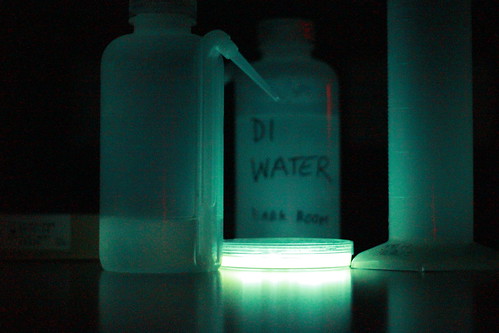So in the mean time, have a bacterial lightbulb:

This was made by this years Cambridge iGEM team (their website can be found here) by growing bacteria on agar, mashing up the agar in a little pot and growing again overnight with liquid medium poured over. Some of the resulting bacterial/agar glowing mush was then put into this lightbulb pendant (brought off ebay) to produce a little glowing bacterial lightbulb. Even better the little clumps of agar look a bit like sort of glowing crystals, which gives it a wonderfully 'science'-y effect.
The lightbulb used DNA from Vibrio fischeri, a bacteria that lives symbiotically with squid. The team acquired plasmids containing this gene controlled by the lux operon, and simply cut away the control, meaning the gene is now constitutively expressed (in the presence of oxygen) and glows away happily without any kind of exterior control. Eventually the lightbulb above will start to fade as the bacteria die and require more nutrients, but it's been sitting in the lab for a day now and is still fairly bright.

They've gotten some wonderfully spooky pictures. I don't know if it's just my imagination, or if I'm expecting this of biological systems, but it all looks faintly green to me. Green glowing things are probably the ultimate achievement in science. As well as their current white glow, they are also starting to get some other colours too, ultimately I believe their hoping for green, blue, orange red and yellow.
I'm really impressed with all their work, considering it's the efforts of nine students over a few months. They've got another month to go before they present it at MIT in Boston, which will require frantic powerpoint slides, and (I've been lead to believe) some potential animation work.


wow. all this while, i thought you were a dude. like a guy. hahaha! you're so awesomee.. keep it up ;)
ReplyDeleteyou're someone's hero already. lol
The bacterial lightbulbs, whilst being great, are not what interest me the most about this iGEM team.
ReplyDeleteOne of their projects involve luciferin regenerating enzymes (LRE) for firefly luciferin.
Firefly luminescence is brighter than bacterial bioluminescence, and with the creation of red-shifted luciferases, it is becoming a more important tool for molecular biology.
Getting a bacterium to express luciferin regenerating enzymes will in theory extend, or allow for self-luminescent strains. As of yet, I haven't seen any papers by people who have gotten it to work. So it will be incredibly useful if the iGEM team managed to get it to work.
@anonymous ha! No, I try not to mention it too much on the blog (because it really doesn't matter) but yeah, officially female. Glad you like the blog :)
ReplyDelete@faz: the LRE work will be the most scientifically exciting, even though the glowing is the most visually impressive. The enzymes are arriving soon, and I'll probably post once they get it working, if not it'll in all likelyhood explode onto their wiki.